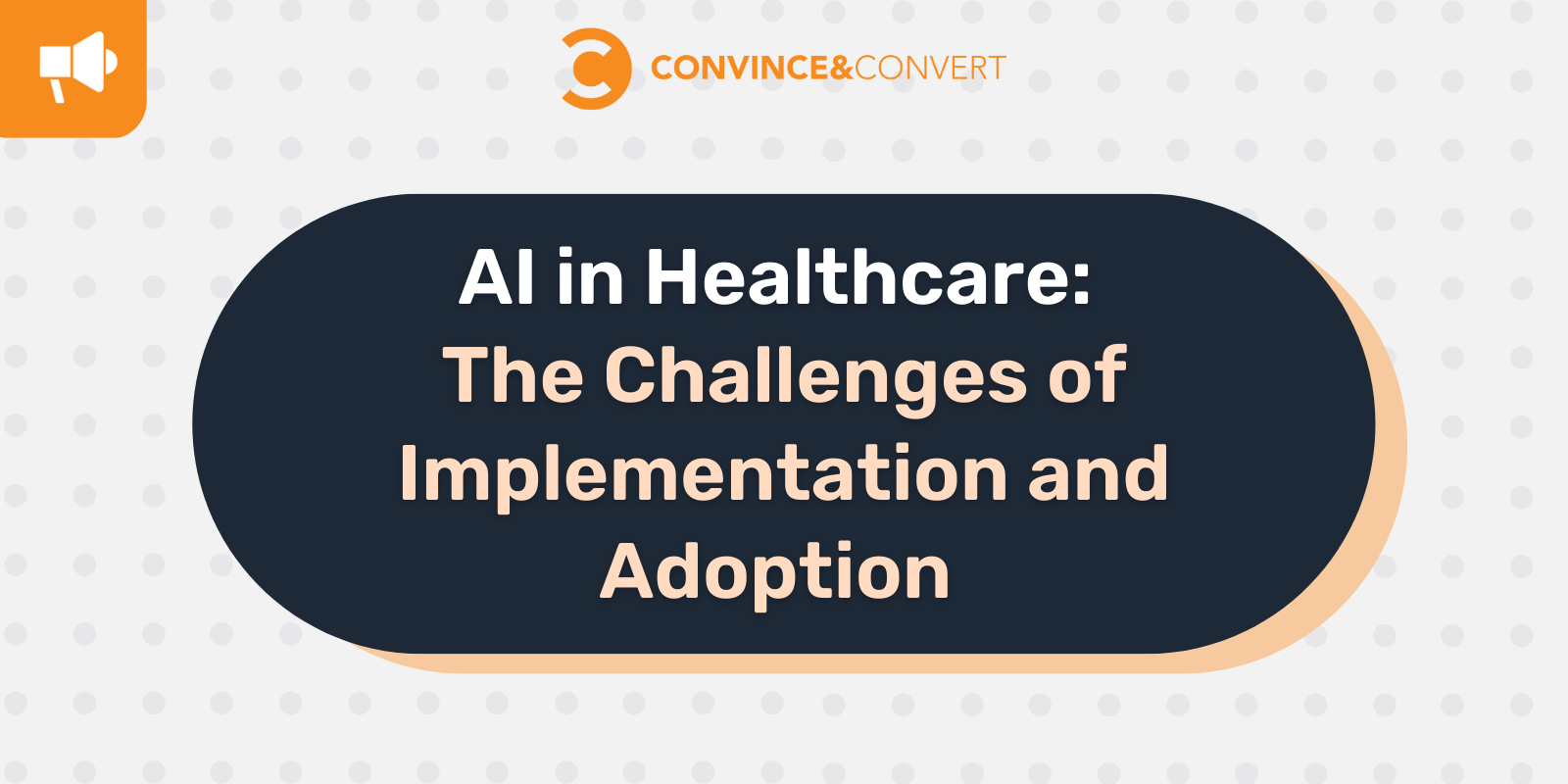
It’s no surprise to anyone that the healthcare industry is struggling right now.
With an ever-growing worker shortage, distrust in the system, and increasing demand for quality service, the industry is in desperate need of solutions.
For years, people have been talking about the revolutionary implications that Artificial Intelligence (AI) could have for healthcare, but as many industries move forward with AI adoption, the healthcare sector has been slow to act.
Is it all just talk, then? Is AI really the answer to healthcare’s woes?
Benefits of AI adoption
From streamlining tedious processes to eliminating them entirely, AI adoption can bring numerous benefits to healthcare providers.
The most obvious benefit is increased efficiency: AI-driven workflows are built for speed, accuracy, and efficiency, allowing healthcare professionals to focus their time and energy on the core aspects of patient care instead of paperwork. By automating certain processes, more data can be collected quickly and accurately, providing a much better understanding of what’s going on within a patient’s health.
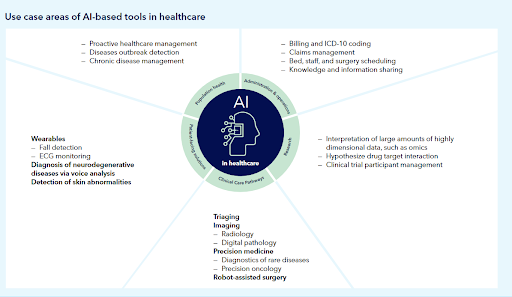
(Source: DNV)
This leads us to the second benefit: AI-driven insights. By gathering data from multiple sources, AI can provide healthcare professionals with better information for decision-making and help them identify patterns, which could be useful in predicting how diseases progress and how treatments might work.
Finally, by automating mundane tasks, AI can free up time for healthcare professionals to focus on more complex and time-consuming projects. This has huge implications when we consider the overworked and understaffed nature of many healthcare facilities.
Decreased risk of burnout is the least of it. Without mundane administrative tasks clogging up their workflow, workers are far more likely to be invested in their duties, to enjoy working, and are able to exercise a greater degree of creativity and empathy, leading to a higher level of quality care for patients.
So why has AI adoption been so slow in the healthcare sector?
There are many considerations to take when it comes to adopting new technology in a field like the healthcare industry.
For instance…
Complexity of integration into existing workflows
Introducing new technology into established systems requires careful planning and testing. And revolutionary technology like AI can be difficult to work with and integrate into existing workflows, which can make investors reluctant to commit to making the change.
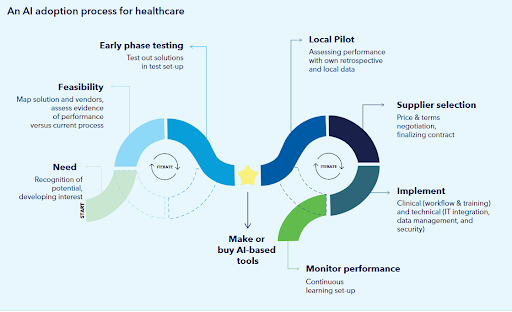
(Source: DNV)
The healthcare industry is also built on a complex system of networks, like insurance and government programs. Any change upstream in a process has the potential to disrupt workflows for other parts of the network, and with this many stakeholders to consult, getting a plan off the ground can be a challenge.
Complementary software and innovations that work with AI are instrumental to the widespread adoption of AI in the healthcare industry, and while there is interest in the technology, development has been centered mostly around big city hospitals and larger healthcare firms. And yes, these are the institutions that are actively hiring AI experts.
Data limitations and concerns
Access to data is a large limiting factor when it comes to how far AI tech can go. With medical data being notoriously difficult to collect and access, the data available for the AI to be trained on cannot be representative of the general population. This limited data must also be processed, filtered, and qualified, which is a time-consuming process.
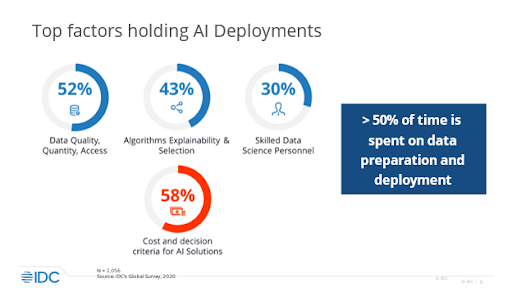
(Source: IDC)
In addition, there are concerns about what kind of data is retained by an AI. Patient privacy is, of course, a priority when it comes to data retention. However, this does mean that security technology has to be developed to keep pace with the rapidly advancing AI solutions and constantly changing needs of healthcare providers.
All in all, there is currently a general lack of…
Trust
At the core of the reluctance to adopt AI is a deep lack of trust in both its utility, its potential, and the safety measures that can curb its pitfalls.
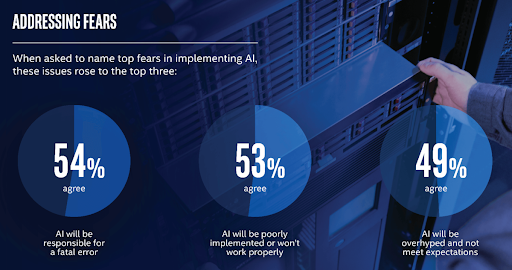
(Source: Internet of Business)
Ethical and regulatory concerns are heavily weighing on the decision-making process when it comes to introducing AI into healthcare. Questions about whether or not an AI will be able to make decisions as accurately as a human and worries that incorrect data could lead to undesired outcomes have caused stakeholders to pause before investing in AI solutions.
The process of obtaining regulatory approval can take a long time, and with the technology being so new, many considerations for privacy and liability have not yet been fully covered within existing legislation.
On top of that, many are concerned about algorithmic bias and how AI models could be affected by pre-existing prejudices. In a field as sensitive as healthcare, social biases that are inadvertently reflected by AI could be cause for serious concern.
Calls for transparency in the development process and greater investment in ethical AI research are growing. But the industry is still a long way away from having any kind of comprehensive oversight.
Resistance to change
The natural human reluctance to adopt change can’t be overlooked. The healthcare industry is built on tradition, and many stakeholders are hesitant to invest in new technology that could disrupt established workflows and require a whole new set of skills.
And while frontline workers who are desperate for a solution to their mounting workloads are often eager to try out new technology, it can be a hard sell for upper management are more risk averse when there is such a large potential for disruption.
You may be interested in our article: AI in Marketing: 5 Things Every Leader Must Do
Examples of successful AI adoption in healthcare
Despite the many challenges, some have embraced the change both nationally and internationally, in small and radical ways.
Using AI for Medical Writing Automation
Just as AI content writing tools like Hubspot and ChatGPT are being used in various industries like marketing, it’s also being used in healthcare to generate content such as patient reports, product descriptions, articles, and medical summaries.
An interesting case study of this is how Pharmeasy, an Indian startup that provides online medicines, telehealth solutions, and diagnostic services, increased organic traffic by 60% by using AI writing.
Using AI to identify cancer tissue
At Houston Methodist Research Institute, researchers have used AI technology to interpret mammograms. They have developed software based on AI tech that helps process patient charts at 99% accuracy and 30 times faster than human speed.
The research team aims for their software to be used by physicians who will be able to assess the risk factors of patients more accurately and reduce the number of false positive mammogram results. They hope that this, in turn, would reduce the number of unnecessary and uncomfortable biopsies performed.
Using virtual nurses for better patient outcomes
Both UCSF and the UK’s NHS have partnered with Sensely, an AI technology development company, and their conversational AI “Molly”.

(Source: Sensely)
Available 24/7, the app can check in with patients on their own time and answer any questions they might have about their treatment. The app can also monitor the mood of the patients and any side effects they might be experiencing from the treatment or medication. This data, along with data from the patient’s other integrated devices, can then be aggregated into a medical record, giving clinicians more accurate histories to base diagnoses on.
Supporting dementia patients with facial recognition AI
Patients suffering from moderate to severe dementia have trouble communicating discomfort or pain to their carers. But by using a tool called PainChek, carers of Dementia Support Australia will be able to tell whether their patients are in pain and provide them with the care they need.
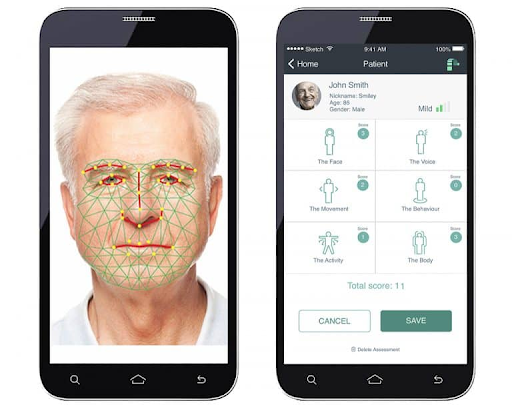
(Source: PainChek)
The tool works by running a 10-second analysis on a patient’s face and assessing pain-related expressions, like lowered brows, tightened eyelids, or slight wrinkling of the nose. PainChek provides Dementia Support Australia’s consultants with a more reliable way to assess pain in dementia patients, one that is less invasive, distressing, and more efficient than previous methods.
Intimidated? Start small.
Adopting AI is not an all-or-nothing process. Beginning the transition involves small, incremental steps.
One common place to start is by migrating your systems to cloud storage as opposed to old software that can be costly to update and maintain. A plan to optimize, collect, and qualify data is also necessary for you to lay the groundwork to eventually use this data. Setting the framework for ethical and privacy standards should also be a priority.
Finally, start educating both providers and patients about the benefits of AI tech in healthcare to help build trust in the technology and get people on board with your vision for a smarter healthcare system. Reassure them that the technology is being used to supplement and enhance the care they are receiving rather than replace them.
By slowly but intentionally introducing AI tech into healthcare, providers can ease the transition for nervous investors and workers, increasing the chances of a successful adoption. So take a deep breath and get your pen and paper out. It’s time to get planning.



